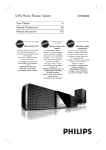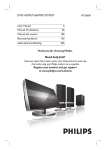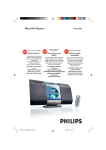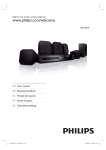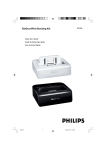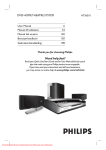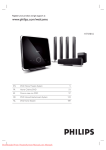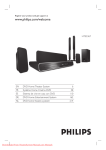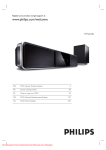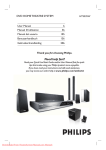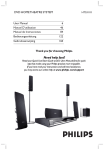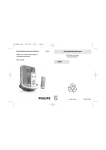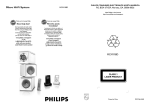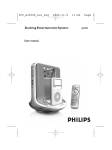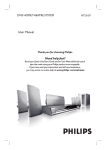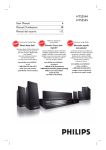Download PYLE Audio HTS8100 User's Manual
Transcript
DVD HOME THEATRE SYSTEM
6
Manuel D’utilisation
56
Manual del usuario
106
Benutzerhandbuch
156
Gebruikershandleiding
206
Read your Quick Start Guide and/or User Manual first for quick tips
that make using your Philips product more enjoyable.
To fully benefit from the support that Philips offers, register your product
and get support at www.philips.com/welcome
English
User Manual
HTS8100
Important notes for users in the
U.K.
Mains plug
This apparatus is fitted with an approved 13
Amp plug. To change a fuse in this type of
plug proceed as follows:
Italia
DICHIARAZIONE DI CONFORMITA’
Si dichiara che l’apparecchio HTS8100, Philips
risponde alle prescrizioni dell’art. 2 comma 1
del D.M. 28 Agosto 1995 n. 548.
Fatto a Eindhoven
1 Remove fuse cover and fuse.
Philips Consumer Electronics
Philips, Glaslaan 2
5616 JB Eindhoven, The Netherlands
2 Fix new fuse which should be a BS1362
5 Amp, A.S.T.A. or BSI approved type.
3 Refit the fuse cover.
If the fitted plug is not suitable for your socket
outlets, it should be cut off and an appropriate
plug fitted in its place.
If the mains plug contains a fuse, this should
have a value of 5 Amp. If a plug without a fuse
is used, the fuse at the distribution board
should not be greater than 5 Amp.
Note: The severed plug must be disposed of to
avoid a possible shock hazard should it be
inserted into a 13 Amp socket elsewhere.
How to connect a plug
The wires in the mains lead are coloured with
the following code: blue = neutral (N),
brown = live (L).
As these colours may not correspond with the
colour markings identifying the terminals in
your plug, proceed as follows:
– Connect the blue wire to the terminal
marked N or coloured black.
– Connect the brown wire to the terminal
marked L or coloured red.
– Do not connect either wire to the earth
terminal in the plug, marked E (or e) or
coloured green (or green and yellow).
Before replacing the plug cover, make certain
that the cord grip is clamped over the sheath
of the lead - not simply over the two wires.
Copyright in the U.K.
Recording and playback of material may
require consent. See Copyright Act 1956 and
The Performer’s Protection Acts 1958 to
1972.
2
Norge
Typeskilt finnes på apparatens underside.
Observer: Nettbryteren er
sekundert innkoplet. Den innebygde
netdelen er derfor ikke frakoplet
nettet så lenge apparatet er
tilsluttet nettkontakten.
For å redusere faren for brann eller elektrisk
støt, skal apparatet ikke utsettes for regn eller
fuktighet.
ATTENTION!
For Customer Use:
Read carefully the information located at the
bottom or rear of your DVD Home Theatre
System and enter below the Serial No. Retain
this information for future reference.
Model No.
HTS8100
Serial No.
_______________
Bemærk: Netafbryderen er sekundært
indkoblet og ofbryder ikke strømmen
fra nettet. Den indbyggede netdel er
derfor tilsluttet til lysnettet så længe
netstikket sidder i stikkontakten.
S
Klass 1 laseraparat
Varning! Om apparaten används på
annat sätt än i denna bruksanvisning
specificerats, kan användaren utsättas
för osynlig laserstrålning, som
överskrider gränsen för laserklass 1.
Observera! Stömbrytaren är sekundärt
kopplad och bryter inte strömmen från
nätet. Den inbyggda nätdelen är därför
ansluten till elnätet så länge
stickproppen sitter i vägguttaget.
SF
Luokan 1 laserlaite
Varoitus! Laitteen käyttäminen muulla
kuin tässä käyttöohjeessa mainitulla
tavalla saattaa altistaa käyttäjän
turvallisuusluokan 1 ylittävälle
näkymättömälle lasersäteilylle.
Oikeus muutoksiin varataan. Laite ei
saa olla alttiina tippu-ja roiskevedelle.
Huom. Toiminnanvalitsin on kytketty
toisiopuolelle, eikä se kytke laitetta irti
sähköverkosta. Sisäänrakennettu
verkko-osa on kytkettynä
sähköverkkoon aina silloin, kun pistoke
on pistorasiassa.
LASER
Type
Wave length
Output Power
Beam divergence
CAUTION
VISIBLE AND INVISIBLE LASER RADIATION
WHEN OPEN. AVOID EXPOSURE TO BEAM
ADVARSEL
SYNLIG OG USYNLIG LASERSTRÅLING VED
ÅBNING UNDGÅ UDSÆTTELSE FOR
STRÅLING
VARNING
SYNLIG OCH OSYNLIG LASERSTRÅLNING
NÄR DENNA DEL ÄR ÖPPNAD BETRAKTA
EJ STRÅLEN
VARO!
AVATTAESSA OLET ALTTIINA NÄKYVÄLLE
JA NÄKYMÄTTÖMÄLLE LASER SÄTEILYLLE.
ÄLÄ KATSO SÄTEESEEN
VORSICHT
SICHTBARE UND UNSICHTBARE
LASERSTRAHLUNG WENN ABDECKUNG
GEÖFFNET NICHT DEM STRAHL
AUSSETZEN
ATTENTION
RAYONNEMENT LASER VISIBLE ET
INVISIBLE EN CAS D’OUVERTURE
EXPOSITION DANGEREUSE AU FAISCEAU
This product complies with the radio
interference requirements of the
European Community.
This product complies with
the requirements of the
following directives and
guidelines: 73/23/EEC +
89/336/EEC + 93/68/EEC
Semiconductor laser
GaAIAs
650 - 660 nm (DVD)
784 - 796 nm (CD)
7 mW (DVD)
10 mW (VCD/CD)
60 degrees
3
English
DK
Advarsel: Usynlig laserstråling ved
åbning når sikkerhedsafbrydere er ude
af funktion. Undgå utsættelse for
stråling.
4
English
Index
Français
Manufactured under license from Dolby
Laboratories, Dolby, Pro Logic and the
double-D symbol are trademarks of Dolby
Laboratories.
Nederlands
Deutsch
Español
Manufactured under license from one or more of
the following DTS, Inc. U.S. Pat. No’s: 5,451,942;
5,956,674; 5,974,380; 5,978,762; 6,226,616;
6,487,535 and other U.S. and world-wide patents
issued and pending. ”DTS” and “DTS Digital
Surround” are registered trademarks of DTS, Inc.
Copyright 1996, 2002-2006, DTS, Inc. All Rights
Reserved.
Windows Media and the Windows logo are
trademarks, or registered trademarks of
Microsoft Corporation in the United States
and/or other countries.
HDMI, and HDMI logo and High-Definition
Multimedia Interface are trademarks or
registered trademarks of HDMI licensing
LLC.
5
Table of contents
English
General
General Information ........................................................................................................ 8
Setup precautions.................................................................................................................................................8
Accessories supplied ...........................................................................................................................................8
Optional GoGear/iPod docking station ........................................................................................................8
About recycling .....................................................................................................................................................8
Product Overview
Main Unit ........................................................................................................................... 9
Remote Control .........................................................................................................10-12
Using the remote control ................................................................................................................................12
Connections
Basic Connections .....................................................................................................13-17
Step 1 : Placement ..............................................................................................................................................13
Step 2 : Connecting to TV ...............................................................................................................................14
Option 1: Using the Scart socket ..........................................................................................................14
Option 2: Connecting to a HDMI-compatible TV ............................................................................14
Option 3: Connecting to a Progressive Scan TV or component video input ............................15
Step 3 : Connecting the FM and AM/MW antennas .................................................................................16
Step 4 : Connecting the subwoofer to the main unit ...............................................................................16
Step 5 : Connecting the power cord ............................................................................................................17
Optional Connections ...............................................................................................18-19
Connecting to cable box/satellite receiver and recorder/VCR ...........................................................18
Mounting the main unit ...................................................................................................................................19
Basic Setup
Getting Started ........................................................................................................ 20-25
Finding the correct viewing channel ............................................................................................................ 20
Setting the speakers ................................................................................................................................. 20~21
Setting language preferences.......................................................................................................................... 22
On-screen display (OSD) language ....................................................................................................... 22
Audio, Subtitle and Menu language for DVD playback .............................................................. 22-23
Setting the TV Display ......................................................................................................................................23
Setting up Progressive Scan feature ..............................................................................................................24
Switching to different play source ................................................................................................................ 25
Turning off to low power standby mode ............................................................................................. 25
Disc Playback
Disc Operations ........................................................................................................ 26-33
Playable discs .......................................................................................................................................................26
Playing a disc ........................................................................................................................................................26
Basic playback controls.....................................................................................................................................27
Selecting various repeat/shuffle functions...................................................................................................27
Programming disc tracks ................................................................................................................................. 28
Other playback features for video discs (DVD/VCD/SVCD) .......................................................28~30
Using the Disc Menu ................................................................................................................................. 28
Viewing playback information ..................................................................................................................29
Zooming in/out ............................................................................................................................................29
Changing subtitle language ......................................................................................................................29
Switching camera angles ............................................................................................................................29
Changing sound track language .............................................................................................................. 30
Setting the delay times for audio playback.......................................................................................... 30
Playback Control (VCD only)................................................................................................................. 30
6
Playing a MP3/WMA disc ................................................................................................................................31
Playing a JPEG image file (slide show) ..........................................................................................................32
Preview function ..........................................................................................................................................32
Zoom picture ..............................................................................................................................................32
Rotating/flipping the picture ....................................................................................................................32
Playing MP3/WMA music and JPEG pictures simultaneously ................................................................33
Playing a DivX disc .............................................................................................................................................33
Playback other supported devices
Playback - GoGear/iPod ................................................................................................. 34
Playing music from compatible GoGear/iPod devices ................................................................... 34
Playback - USB device .................................................................................................... 35
Playing from USB flash drive or USB memory card reader....................................................................35
Playback - Other Audio Player ..................................................................................... 36
Playing from other portable audio player ....................................................................................................36
Setup Options
Setup Menu Options................................................................................................ 37-44
Accessing the setup menu................................................................................................................................37
General Setup Page........................................................................................................................................... 38
Audio Setup Page................................................................................................................................................39
Video Setup Page .........................................................................................................................................40-42
Preference Setup Page ...............................................................................................................................43-44
Radio Tuning
Radio Operations ...................................................................................................... 45-46
Tuning to radio stations................................................................................................................................... 45
Presetting radio stations ................................................................................................................................. 45
Using auto install ..................................................................................................................................45-46
Using automatic preset............................................................................................................................. 46
Using manual preset .................................................................................................................................. 46
Selecting a preset radio station ..................................................................................................................... 46
Deleting a preset radio station...................................................................................................................... 46
Others
Sound and Volume Controls ......................................................................................... 47
Volume control ...................................................................................................................................................47
Adjusting the Bass/ Treble level .....................................................................................................................47
Selecting surround sound.................................................................................................................................47
Other Features................................................................................................................48
Software upgrades ............................................................................................................................................ 48
Troubleshooting .........................................................................................................49-51
Frequently Asked Questions (USB) ............................................................................. 52
Specifications .................................................................................................................. 53
Glossary...................................................................................................................... 54-55
Language Code.............................................................................................................. 257
7
English
Table of contents
General Information
English
WARNING!
This unit does not contain any userserviceable parts. Please leave all
maintenance work to qualified
personnel.
Setup precautions
Finding a suitable location
– Place this unit on a flat, hard and
stable surface. Never place the unit on a
carpet.
– Never place this unit on top of other
equipment that might heat it up (e.g.,
receiver or amplifier).
– Never put anything under this unit
(e.g., CDs, magazines).
– Install this unit near the AC outlet
where the AC power plug can be easily
reached.
8
Accessories supplied
– 1 subwoofer
– 1 wall mounting bracket and 2 wall
mounting knobs
– 1 remote control with batteries
– 1 scart cable
– 1 audio cable (3.5mm to RCA)
– 1 FM wire antenna
– 1 AM/MW loop antenna
– 1 MP3 LINE-IN cable (for connecting
portable audio player)
– 1 micro fibre cleaning cloth
– 1 power cable
– Quick Start Guide
Optional GoGear/iPod
docking station
Space for ventilation
– Place this unit in a location with
adequate ventilation to prevent internal
heat build up. Allow at least 10 cm (4”)
clearance from the rear and the top of
this unit and 5cm (2”) from the left and
right to prevent overheating.
This is an optional feature. The docking
station available only in selected
countries.
Avoid high temperature, moisture,
water and dust
– This unit must not be exposed to
dripping or splashing.
– Never place any object or items that
can damage this unit (e.g., liquid filled
objects, lighted candles).
These operating instructions have been
printed on non-polluting paper. The
electronic equipment contains a large
number of materials that can be recycled.
If you are disposing of an old machine,
please take it to a recycling centre.
Please observe the local regulations
regarding disposal of packaging materials,
exhausted batteries and old equipment.
About recycling
Main Unit
11
10
9
8
7
English
Top view
6
5
4
3
2
1
7
Left side view
Front view
a STANDBY ON 2
g iR sensor
– Turns on this unit or turns off to normal
standby mode.
– Press and hold to turn off to low power
standby mode.
– Point the remote control towards this
sensor.
h Disc compartment
b SOURCE
i USB socket
– Selects the relevant active source mode:
DISC, USB, DOCK, MP3 LINE-IN,
RADIO FM, RADIO AM/MW, TV1, TV2,
AUX1, AUX2 or DIGITAL IN.
– Input for USB flash drive or USB memory
card reader.
j MP3 LINE-IN socket
– Adjusts the volume level.
– Phono input for connecting to the
headphone out socket on your portable
audio player.
d PLAY PAUSE u
k DOCK socket
c VOLUME +-
– DISC: starts/pauses playback.
– RADIO: starts auto radio installation for
first time setup.
– Input for GoGear/iPod docking station
(optional feature - available in selected
countries).
STOP Ç
– Exits an operation.
– DISC: stops playback.
– RADIO: press and hold this button to
erase the current preset radio station.
e OPEN/CLOSE ç
– Opens/closes the disc compartment.
f Display panel
9
Remote Control
English
10
Remote Control (continued)
English
n DISC MENU
– For DVD, enters or exits disc contents
menu.
– For VCD/SVCD, enters digest menu
while in stop mode; turns on/off PBC
mode during playback.
o OK
– Confirms an entry or selection.
14
p Cursor keys
15
– DISC: selects movement direction in the
menu.
– RADIO: press up or down to tune the
radio frequency.
– RADIO: press left or right to start auto
search.
16
19
q TITLE 2
20
– For DVD, go back to the previous menu.
– For VCD version 2.0 only;
During playback, display the disc title
menu or return to the main menu.
17
18
21
22
r PREV / REW ., NEXT / FFW >
23
– DISC: skips to the previous or next title/
chapter/track.
– DISC: press and hold this button for fast
forward and backward search.
– RADIO: selects a preset radio station.
24
s MUTE
– Mutes or restores the volume.
t VOL +– Adjusts the volume level.
u AMBISOUND
– Switches the surround sound mode
between Auto, Multi-Channel and Stereo
mode.
v SELECT/PROGRAM
– DISC: starts programming.
– RADIO: press and hold this button to
start automatic/ manual preset
programming.
– Make multiple selection in the menu.
AMBISOUND
25
26
w TREBLE / BASS
– Toggles between Treble and Bass mode.
Immediately after toggling, adjust the
volume control to change the level
settings
x AUDIO SYNC
– Sets the audio output delay times if the
video playback is slower than the audio
output.
y SUBTITLE
– Selects a DVD subtitle language.
z ANGLE
– Selects a different viewing angle of a DVD
movie (if available).
11
Remote Control (continued)
English
Using the remote control
A Open the battery compartment.
B Insert two batteries type R06 or AA,
following the indications (+-) inside
the compartment.
C Close the cover.
D Point the remote control directly at the
remote sensor (iR) on the front panel.
E Select the source you wish to control by
pressing the DISC, DOCK, USB, RADIO,
AUX, DIGITAL IN, TV or MP3 LINE-IN
button on the remote control.
F Then select the desired function (for
example ., >).
12
CAUTION!
– Remove batteries if they are
exhausted or if the remote control
is not to be used for a long time.
– Never mix batteries (old and new
or carbon and alkaline, etc.).
– Batteries contain chemical
substances, they should be disposed
of properly.
English
Basic Connections
Step 1: Placement
Note:
Never place the main unit in an enclosed
cabinet.
Helpful Hints:
– For optimum performance, place the main
unit on top of a table or mount it on the
wall.
– For Sound Bar speaker setting, see
‘Getting Started - Setting the speakers’.
A Place the main unit at a height that is
closest to the listening ear-level.
B Position the main unit so that it is directly
parallel to the listening area.
C Place the subwoofer at the corner of the
room or at least one metre away from
the TV.
13
English
Step 2: Connecting to TV
This connection enables you to view the
video playback from this unit. You only
need to choose one of the options
below to make the video connection.
– For a standard TV, follow option 1.
– For a HDMI TV, follow option 2.
– For a progressive scan TV, follow
option 3.
Before you start ...
Push up the catches to lift up the rear
cover.
14
English
Basic Connections (continued)
TV AUDIO IN
(TV 2)
TO SUBWOOFER
COMPONENT
Option 3
INTERFACE TO
SUBWOOFER
Option 3: Connecting to a
Progressive Scan TV or component
video input
The progressive scan video quality is only
available when using Y Pb Pr connection
and a progressive scan TV is required. It
provides superior picture quality when
watching DVD movies.
Helpful Hints:
– Audio connection is not required if the
main unit is connected to your TV using the
SCART connector.
– To hear the TV programmes through this
Home Theatre System, press TV button on
the remote control to select ‘TV2’ as the
sound source you want to listen to.
A Use the component video cables (red/
blue/green - not supplied) to connect the
COMPONENT VIDEO OUT
(Y Pb Pr) sockets on the main unit to
the corresponding component video
input sockets (or labelled as Y Pb/Cb
Pr/Cr or YUV) on the TV.
B If your TV accepts progressive signals,
proceed to chapter ‘Getting Started Setting up Progressive Scan feature’ for
detailed progressive feature setup.
C To hear the TV channels through this
unit, use the supplied audio cable to
connect the TV AUDIO IN (TV2) to
the AUDIO OUT sockets on the TV.
15
Basic Connections (continued)
English
AM/MW antenna
fix the claw
into the slot
FM/MW ANTENNA
MW
FM 75
L
R
COAXIAL
DIGITAL IN
AUX 1
AUX 2
TO MAIN UNIT
MAINS
SPEAKERS
RIGHT
LEFT
FM/AM/MW ANTENNA
AM/MW FM 75
FM antenna
Ñ LOUDSPEAKERS
TO SUBWOOFER
L
R
COAXIAL
DIGITAL IN
AUX 1
AUX 2
TO MAIN UNIT
MAINS
TO SUBWOOFER
Step 3: Connecting the
FM and AM/MW
antennas
FM antenna
A Connect the FM antenna (supplied) to
the FM 75 Ω socket.
B Attach the other end of the FM antenna
to a wall.
AM/MW loop antenna
A Stand the AM/MW loop antenna upright
to fix its claw into the slot.
B Connect the AM/MW loop antenna to
the AM/MW socket.
C Place the AM/MW loop antenna on a
shelf, or attach it to a stand or wall.
Helpful Hints:
– Adjust the position of the antennas for
optimal reception.
– To avoid interference, position the antenna
away from the electronic equipment.
– For better FM stereo reception, connect an
external FM antenna (not supplied).
16
Step 4: Connecting the
subwoofer to the
main unit
A Unwind the subwoofer’s TO MAIN
UNIT interconnect cable.
B Connect the white end of the
interconnect cable to the
LOUDSPEAKERS socket on the main
unit.
C Connect the black end of the
interconnect cable to the TO
SUBWOOFER socket on the main
unit.
English
Basic Connections (continued)
SPEAKERS
RIGHT
LEFT
FM/AM/MW ANTENNA
AM/MW FM 75
L
R
COAXIAL
DIGITAL IN
AUX 1
AUX 2
TO MAIN UNIT
MAINS
Step 5: Connecting the
power cord
Note:
For power supply rating, refer to the rear
or bottom of the main unit.
A When all the connections are complete,
direct all the cables to the CABLE OUT
point.
B Close the rear cover.
Note:
All the cables must be placed properly
inside the rear panel in order for the rear
cover to close.
C Connect the AC power cord from the
subwoofer to the power outlet.
The standby LED on the main unit
lights up.
Helpful Hint:
– Before making or changing any
connections, make sure that all the devices
are disconnected from the power outlet.
17
Optional Connections
English
Connecting to cable box/
satellite receiver and
recorder/VCR
This unit provides analogue and digital
audio connection. You can connect the
audio output from an audio/video device
(e.g. DVD recorder, VCR, Cable/Satellite
Box) to this Home Theatre System in
order to enjoy the multi-channel
surround sound capabilities.
Note:
The above illustration is only an example
of the possible connections. It may be
varied depending on the connected
devices.
A Keep the existing connections between
your TV and other devices.
18
English
Optional Connections (continued)
D Repeat step three to remove the other
Mounting the main unit
speaker foot.
E Position and mark the supplied bracket
CAUTION!
Risk of personal injury and damage
to the unit. Allow only qualified
persons to mount the unit.
where you intend to mount the main
unit.
F Drill the screw holes.
G Insert the rubber wall plugs (not
Before you start ...
Make sure that all cables have been
connected to the main unit.
supplied) into the holes.
H Secure the bracket onto the wall with the
screws (not supplied).
A Attach the supplied knobs to the rear of
the main unit.
B Turn the main unit over so that the
bottom of the main unit faces up.
C While you hold the main unit firmly with
one hand, grasp one of the rubber
speaker feet and push it towards the back
of the main unit.
I Hook the main unit firmly onto the
mounted bracket. Slide the knobs
through the bracket’s key holes and lock
into position.
Helpful Hint:
– To mount the main unit below your TV,
leave at least 10cm (4 inches) of space
between the TV and the bracket.
19
Getting Started
English
Finding the correct viewing
channel
Before you start ...
Remove the door stop tag on top of the
disc compartment door.
A Press SOURCE button on the main unit
until ‘DISC SOURCE’ appears on the
display panel (or DISC on the remote
control).
B Turn on the TV and switch it to the
correct video-in channel.
You may go to the lowest channel on
your TV, then press the Channel Down
button on your TVs remote control until
you see the Video In channel.
You may press ° button repeatedly
on your TVs remote control.
Usually this channel is between the
lowest and highest channels and may be
called FRONT, A/V IN, VIDEO, etc..
Refer to your TVs user manual on
how to select the correct input on your
TV.
Setting the speakers
There are four parameters to adjust the
speakers: room acoustics, placement,
height and distance. Change the speaker
settings according to your room
environment and setup.
A Upon seeing the welcome message in
‘DISC SOURCE’ mode, press cursor right
key on the remote control to access the
speaker setup screen.
A message on the unit positioning
appears.
Orientation
Ensure that the SoundBar system is always
directly facing you in your listening area.
ds
Continue
B Press cursor right key to continue.
{ Room Acoustics } menu appears.
Room Acoustics
Please select the type of walls that surround
The first screen appears on TV
When you complete the connections and
turn on this unit to the ‘DISC SOURCE’
mode for the first time, you see the
welcome message on the TV.
Welcome
The next few steps will help you set up your
Ambisound home theater system to match your
listening environment.
Stop: Exit
Continue
It is advisable that you make several basic
settings to optimise the performance of
this unit. See the following pages for
more information.
20
your room:
Hard (Concrete, wood)
Soft (Curtains, open space)
ds
Back
Change
Select
C Select the condition of the room and
press cursor right key to confirm.
{ Hard } for concrete or wood
surroundings.
{ Soft } for curtains or an open space
surroundings.
English
Room Placement
Select the Sound Bar system placement position
in your room:
Middle of the room
ds
Corner of room
Wall on the right
Wall on the left
Back
Change
Select
D Select Sound Bar system placement
position in the room and press cursor
right key to confirm.
Select
21
English
Setting language preferences
Audio, Subtitle and Menu language
for DVD playback
The language options are different
depending on your country or region. It
may not correspond to the illustrations
shown in the user manual.
You can select your preferred language
settings for DVD playback. If the
selected language is recorded on the
DVD disc, this unit automatically plays
the disc in that language. Otherwise, the
disc’s default language will be used
instead.
On-screen display (OSD) language
The OSD (On-Screen Display) language
for this unit remains as you have set it,
regardless of the changes made to the
DVD disc language.
A In disc mode, press SETUP on the
remote control.
{ General Setup Page } appears.
A Press Ç twice to stop playback (if any),
then press SETUP.
B Press cursor right key repeatedly to
select { Preference Page }.
C Select one of the options below and
press cursor right key.
B Select { OSD Language } in the menu
and press cursor right key.
General Setup Page
Ambisound Setup
Disc Lock
Display Dim
OSD Language
Screen Saver
Sleep
DivX(R) VOD Code
English
Dansk
Deutsch
Espanõl
Français
Nederlands
Norsk
C Select a language and press OK to
confirm.
Preference Page
Audio
Subtitle
Disc Menu
Parental
PBC
MP3/JPEG Nav
Password
DivX Subtitle
Default
English
French
Spanish
Portuguese
Polish
Italian
Turkish
Greek
{ Audio }
Select the preferred audio language for
DVD playback.
{ Subtitle }
Select the preferred subtitle language for
DVD playback.
{ Disc Menu }
Select the preferred disc menu language
for DVD playback.
D Select a language and press OK to
confirm.
22
If the language you want is not
available in the list, select { Others }.
Use the numeric keypad 0-9 on the
remote control to enter the 4-digit
language code ‘XXXX’ (see last page) and
press OK to confirm.
E Repeat steps C ~ D for other settings.
Helpful Hints:
– During DVD playback, you can switch the
audio and subtitle languages by pressing the
AUDIO and SUBTITLE buttons on the
remote control. However, this does not
change the default settings you have made
here.
– For some DVDs, the subtitle/audio/menu
language can only be changed via the DVD
disc menu.
Setting the TV Display
Set the aspect ratio of this unit according
to the TV type you have connected. The
format you select must be available on
the disc. If it is not, the setting for TV
display will not affect the picture during
playback.
A In disc mode, press SETUP on the
remote control.
B Press cursor right key repeatedly to
select { Video Setup Page }.
C Select { TV Display } in the menu and
press cursor right key.
Video Setup Page
TV Type
TV Display
Picture Setting
Component
Progressive
Adv Picture
4:3 Pan Scan
4:3 Letter Box
16:9 Wide Screen
{ 4:3 Pan Scan }
Select this if you have a
conventional TV and
want both sides of the
picture to be trimmed or formatted
to fit your TV.
{ 4:3 Letter Box }
Select this if you have a
conventional TV. In this
case, a wide picture with
black bands on the upper and lower
portions of the TV will be displayed.
{ 16:9 Wide Screen }
Select this if you have a
wide-screen TV.
D Select one of the options and press OK
to confirm.
23
English
Getting Started (continued)
Getting Started (continued)
English
Setting up Progressive Scan
feature
(for Progressive Scan TV only)
The progressive scan displays twice the
number of frames per second than
interlaced scanning (ordinary normal TV
system). With nearly double the number
of lines, progressive scan offers higher
picture resolution and quality.
Before you start...
Ensure that you have connected this unit
to a progressive scan TV using the Y Pb
Pr connection (see ‘Option 3: Connecting
to a Progressive Scan TV or component
video input’).
A Turn on the TV to the correct viewing
channel for this unit.
Make sure that the TVs progressive
scan mode is turned off (or set to
interlaced mode). Refer to your TVs user
manual.
B Turn on this unit and press DISC on the
remote control.
C Press SETUP on the remote control.
D Press cursor right key repeatedly to
select { Video Setup Page }.
Video Setup Page
TV Type
TV Display
Picture Setting
Component
Progressive
Adv Picture
YUV
RGB
E Move to { Component } > { YUV } in
the menu and press OK to confirm.
24
F Move to { Progressive } > { On } in the
menu and press OK to confirm.
Video Setup Page
TV Type
TV Display
Picture Setting
Component
Progressive
Adv Picture
On
Off
English
Switching to different play
source
Press the SOURCE button on the main
unit repeatedly to select:
DISC SOURCE USB DOCK
MP3 LINE-IN RADIO FM
RADIO AM/MW TV1 TV2
AUX1 AUX2 DIGITAL IN
DISC SOURCE ....
25
Disc Operations
English
Playable discs
Note:
– If the inhibit icon (ø or X) appears
on the TV when a button is pressed,
it means the function is not
available on the current disc or at
the current time.
– Never put any objects other than
discs on the disc tray. Doing so may
cause the disc player to malfunction.
Playing a disc
Your DVD home theatre system
plays:
– Digital Versatile Discs (DVDs)
– Video CDs (VCDs)
– Super Video CDs (SVCDs)
– Finalised DVD Recordable (DVD±R),
DVD Rewritable (DVD±RW)
– Audio Compact Discs (CDs)
– MP3/ Windows Media™ Audio discs,
picture (Kodak, JPEG) files on
CD-R(W)
– ISO 9660
– JPEG resolution support up to
3072 x 2048
– Supported sampling frequencies :
32 kHz, 44.1 kHz, 48 kHz
– Supported Bit-rates : 32~256 (kbps),
variable bit rates (average 128 kbps)
– DivX files on CD-R(W)/DVD+R(W):
– DivX 3/4/5/6, DivX Ultra
Region Codes for DVD discs
DVD discs and players are designed with
regional restrictions. Before playing a disc,
make sure the disc is for the same region
as your player. The regional code for this
unit is indicated at the rear or bottom
panel.
26
A Press SOURCE repeatedly until ‘DISC
SOURCE’ appears on the display panel
(or press DISC on the remote control).
B Turn on the TV to the correct viewing
channel for this unit.
The blue DVD background screen
appears on the TV.
C Press OPEN/CLOSE ç to open the
disc compartment.
D Insert a disc into the disc compartment
and press OPEN/CLOSE ç.
Make sure the disc label is facing
towards you. For double-sided discs, load
the side which you want to play facing up.
E Playback starts automatically.
See the following pages for more
playback options and features.
Helpful Hints:
– If you are having trouble playing a certain
disc, remove the disc and try a different one.
Improperly formatted discs cannot be played
on this unit.
– Some discs cannot be played on this player
due to the configuration and characteristics
of the disc, or due to the condition of
recording and authoring software that was
used.
Basic playback controls
Pausing playback
During playback, press u.
While in pause mode, you can press
cursor left/right keys repeatedly to view
the previous or next still picture (for
video playback only).
To resume playback, press u again.
Selecting another track/chapter
Press ./ > or use the numeric
keypad 0-9 to key in a track/chapter
number.
If the repeat track mode is active, press
. again to replay the same track/
chapter.
Searching backward/forward
Press and hold ./ >.
While searching, press ./ >
repeatedly to decrease/increase the
search speed.
To resume normal playback, press
u.
Stopping playback
Press x.
Helpful Hints:
– If the message ‘To playback from the
beginning, press PREV key’ appears on the
TV while you load in a disc, you can press
. to playback from the beginning.
– This is a power-saving feature, this unit
automatically switches to low power standby
mode if you do not press any buttons within
30 minutes after a disc has stopped playing.
English
Disc Operations (continued)
Selecting various repeat/
shuffle functions
The available of the repeat play options
and shuffle play mode are vary depending
on the disc type.
While playing a disc, press
REPEAT/SHUFFLE on the remote
control repeatedly to choose a repeat/
shuffle play mode.
DVD
REPEAT CHAPTER
REPEAT TITLE
REPEAT DISC
SHUFFLE
SHUFFLE REPEAT
REPEAT OFF (exit repeat mode)
VCD/SVCD/CD
REPEAT TRACK
REPEAT DISC
SHUFFLE
SHUFFLE REPEAT
REPEAT OFF (exit repeat mode)
MP3/DivX/Windows Media™ Audio
REPEAT TRACK
REPEAT ALL / FOLDER
SHUFFLE
REPEAT OFF (exit repeat mode)
Helpful Hint:
– Repeat playback is not possible on VCDs
when the PBC mode is turned on.
27
Disc Operations (continued)
English
Programming disc tracks
(not for Picture CD/MP3)
You can play the contents of the disc in
the order you want by programming the
playing order of the tracks.
A Press SELECT/PROGRAM on the
remote control.
The programming menu appears.
6
7
2
8
9
10
Exit
Start
Next
B Use the numeric keypad 0-9 to enter a
valid track/chapter number.
C Use the cursor keys to move the cursor
to the next position.
If there are more than ten total
programme tracks, select { Next } on
the screen and press OK (or press >
on the remote control) to access the
next programming page.
To remove the track/chapter from the
programming menu, select the track/
chapter and press OK.
D Once complete, select { Start } on the
screen and press OK to start playback.
Playback starts from the selected track
under the programmed sequence.
E To exit the programme menu, select
{ Exit } in the menu and press OK.
28
Other playback features
for video discs (DVD/VCD/
SVCD)
Viewing playback information
This unit can display the disc playback
information (for example, title or chapter
number, elapsed playing time, audio/
subtitle language) and a number of
operations can be done without
interrupting disc playback.
A During playback, press DISPLAY.
A list of available disc information
appears on the TV.
DVD
Zooming in/out
This option allows you to zoom in or out
the picture on the TV and to pan through
the picture.
A During playback, press ZOOM
repeatedly to select a different zoom
factor.
Playback continues.
B Use the cursor keys to pan through the
zoomed image.
C Press ZOOM repeatedly to return to
the original size.
Changing subtitle language
VCD/SVCD
Menu
Track
Disc Time
Track Time
Repeat
Time Disp.
01/12
0:49:17
0:04:32
Off
Total Elapsed
Bitrate 8
Total Elapsed
B Use cursor up/down keys to view the
information and press OK to access.
C Use the numeric keypad 0-9 to input
the number/time or use cursor up/down
keys to make the selection.
D Press OK to confirm.
This operation works only on DVDs with
multiple subtitle languages. You can
change the language you want while
playing a DVD.
Press SUBTITLE repeatedly to select
different subtitle languages.
Switching camera angles
This option is only available on DVDs
that contain sequences recorded from
different camera angles. This allows you
to view the picture from different angles.
If the camera icon appears on the TV,
press ANGLE repeatedly to select the
available camera angles.
Playback changes according to the
chosen time or to the selected title/
chapter/track.
29
English
Disc Operations (continued)
Disc Operations (continued)
English
Changing sound track language
This operation works only on DVDs with
multiple sound track languages, or VCDs
with multiple audio channels.
Press AUDIO repeatedly to select the
available audio languages.
For VCD – changing the audio
channel
Press AUDIO repeatedly to select the
available audio channels provided by the
disc (STEREO, MONO LEFT, MONO
RIGHT or MIX MONO).
Setting the delay times for audio
playback
This feature allows you to adjust the
audio delay times if the video playback is
slower than the audio output streams,
which is called ‘Lip-sync’. The only way to
correct ‘Lip-sync’ error caused by
delayed video is to delay audio by an
equal amount.
A Press AUDIO SYNC.
B Within five seconds, use the VOL +to set the audio output delay times (0 ~
150 ms).
If the volume control is not used
within five seconds, it resumes normal
volume control function.
30
Playback Control (VCD only)
Playback Control (PBC) playback allows
you to play Video CDs interactively,
following the menu on the display. This
function can also be accessed via the
‘Preference Page’ menu.
For VCDs with Playback Control
(PBC) feature (version 2.0 only)
During playback, press TITLE 2 to
return to the disc title menu or main
menu.
During playback, press DISC MENU to
turn on or off the PBC mode.
Disc Operations (continued)
This unit can playback most of the MP3
and Windows Media™ Audio files
recorded on a recordable disc or
commercial CD.
Before you start ...
Turn on your TV to the correct Video In
channel. See ‘Finding the correct viewing
channel’ for details.
A Insert a MP3/WMA disc.
The disc reading time may exceed 30
seconds due to the complexity of the
directory/file configuration.
The disc menu appears on the TV.
00:19 04:39
001/003
\MP3_files_128kbs
Previous
Picture 1
Picture 2
MP3 Music 1
MP3 Music 2
050
003
000 USB
B If the disc main menu contains various
folders, use cursor up/down keys to
select a desired folder and press OK to
open the folder.
During playback;
English
Playing a MP3/ WMA disc
Press ./ > to playback another
track/file in the current folder.
Press and hold ./ > to fast
reverse/forward search for a music track.
To select another folder from the
current disc, press cursor up key to
return to the root menu.
Press REPEAT/SHUFFLE repeatedly
to access various play modes.
D To stop playback, press x.
Helpful Hints:
– To skip the folders menu when you load a
MP3/JPEG disc, set the MP3/JPEG NAV
setting in the Preference Setup Page to
{ Without Menu }.
– Only the first session of a multi-session CD
will be played back.
– It is normal to experience an occasional
‘skip’ while listening to your MP3/WMA disc
due to poor clarity of digital contents during
internet downloading.
– If any special characters are present in the
MP3 track name (ID3) or album name, it
might not be displayed correctly on the
screen because this unit does not support the
characters.
C Use cursor up/down keys to select a
track/file and press OK to start playback.
Playback starts from the selected file
and continues through to the end of the
folder.
31
Disc Operations (continued)
English
Playing a JPEG image file
(slide show)
Before you start ...
Turn on your TV to the correct Video In
channel. See ‘Finding the correct viewing
channel’ for details.
Insert a JPEG photo CD (Kodak Picture
CD, JPEG).
For a Kodak disc, the slide show
begins automatically.
For a JPEG disc, the picture menu
appears on the TV. Press u to start the
slide-show playback.
Helpful Hint:
– It may require longer time for this unit to
display the disc content on the TV due to the
large number of songs/pictures compiled into
one disc.
Supported file format:
– The file extension has to be ‘*.JPG’
and not ‘*.JPEG’.
– This unit can only display digital camera
pictures according to the JPEG-EXIF
format, typically used by almost all digital
cameras. It cannot display Motion JPEG,
progressive JPEG and other JPEG
formats, or pictures in formats other
than JPEG, or sound clips associated with
pictures.
Preview function
A During playback, press x.
12 thumbnail pictures will be displayed
on the TV.
B Press ./ > to display the other
pictures on the previous/next page.
C Use the cursor keys to select one of the
pictures and press OK to start playback.
D Press DISC MENU to return to Picture
CD menu.
Zoom picture
A During playback, press ZOOM
repeatedly to select a different zoom
factor.
B Use the cursor keys to pan through the
zoomed image.
Rotating/flipping the picture
During playback, use the cursor keys to
rotate/flip the picture on the TV.
– cursor up: flip the picture vertically.
– cursor down: flip the picture
horizontally.
– cursor left: rotate the picture counterclockwise.
– cursor right: rotate the picture
clockwise.
32
Playing MP3/WMA music and
JPEG pictures simultaneously
You can create a musical slide show if the
disc contains both the MP3/WMA music
and JPEG picture files.
A Insert a MP3/WMA that contains music
and picture folders.
B Select a track in the menu and press u
to start playback.
C During music playback, use the cursor
keys to select a picture folder from the
disc menu and press u.
The picture files will be played back
through to the end of the folder.
The music keeps playing back and will
be repeated if reaches the end of the
selected album, playlist or track.
D To stop simultaneous playback, press
DISC MENU followed by x.
Playing a DivX disc
This unit supports the playback of DivX
movies which you can copy from your
computer onto a recordable disc. See
‘Setup Menu Options - { General Setup
Page - DivX(R) VOD code }’ for details.
A Insert a DivX disc.
B Use the cursor keys to navigate to the
title you want to play.
C Press u to start playback.
During playback;
If the DivX disc has multilingual subtitles,
you can press SUBTITLE on the
remote control to change the subtitle
language.
If the DivX title has different audio
tracks, you can press AUDIO on the
remote control to change the audio
stream.
Use the cursor left/right keys on the
remote control to perform fast reverse/
forward search.
For DivX Ultra disc only, press
DISPLAY to view the video
information.
Helpful Hints:
– Subtitle files with the following file name
extensions (.srt, .smi, .sub, .ssa, .ass) are
supported but do not appear on the file
navigation menu.
– The subtitle file name has to be the same
as the file name of the movie.
– The subtitle can only be displayed up to an
average of 45 characters.
33
English
Disc Operations (continued)
Playback - GoGear/iPod
English
Playing music from
compatible GoGear/iPod
devices
(Optional feature - not available in Europe)
Music on your Philips GoGear/Apple iPod
can be played on this unit with the
support of Philips HTD7001 docking
station (optional feature - available in
selected countries). It enables you to
enjoy superior sound output from the
speaker system.
Philips HTD7001 docking station
supports the following GoGear/iPod
range:
GoGear
iPod
HDD1420, 1430
HDD1620, 1630, 1635
HDD1820, 1830, 1835
HDD1840, 1850
HDD6320, 6330
60/80GB (video)
40/60GB (color display)
30GB (video)
20/30GB (color display)
Nano
40GB
20GB
MINI 4GB
Before you start ...
Prepare the Philips HTD7001 docking
station by attaching the matching dock
adaptor to the correct docking cradle.
Refer to the Docking Station’s user
manual for more information.
HTS8100
HTD7001
34
Playing from USB flash drive
or USB memory card reader
You can play or view the data files (JPEG,
MP3, Windows Media™ Audio or DivX)
in the USB flash drive or USB memory
card reader. However, editing or copying
the data file is not possible.
A Connect the USB flash drive / USB
memory card reader directly to the USB
socket on this unit.
D Select the file to play and press u.
For more playback information, see
‘Playing a MP3/WMA disc’, ‘Playing a JPEG
image file (slideshow)’ or ‘Playing a DivX
disc’ for details.
E Before removing the USB device, press x
to stop playback or press DISC to
switch to disc mode.
Helpful Hints:
– The USB socket does not support the
connection of other USB devices except to a
USB flash drive / USB memory card reader.
– When the USB device does not fit into the
USB socket, a USB extension cable is
required.
– You can only read and playback the
content from the USB device.
– Copy-protected contents are not playable.
B A message appears on the TV for 5 (five)
seconds when the device is detected.
Press USB to select device
C Press USB on the remote control to
access the data in the drive.
When using multiple drives on a single
card reader, only one of the connected
cards can be accessed.
The device numbers may vary from
different card readers.
35
English
Playback - USB Device
Playback - Other Audio Player
English
Playing from other portable
audio player
When you connect your portable audio
player to this unit to get the best
immersion sound experience through the
speaker system. However, controlling of
playback is only possible on the portable
audio player.
MP3
LINE-IN
A Use the supplied MP3 LINE-IN cable to
connect between the ‘headphone’ output
socket on your portable audio player and
the MP3 LINE-IN socket on this unit.
B Press MP3 LINE-IN on the remote
control.
C Start playback on your portable audio
player.
The music will be heard through the
speakers.
D To stop playback, press the STOP button
on the portable audio player.
Helpful Hint:
– If you change the input source by pressing
any of the source buttons (e.g. DISC, USB,
RADIO), press the STOP button on the
portable audio player to stop its playback.
36
Accessing the setup menu
This system setup is carried out via the
TV, enabling you to customise this unit to
suit your particular requirements.
English
Setup Menu Options
General Setup Page
Ambisound Setup
Disc Lock
Display Dim
OSD Language
Screen Saver
Sleep
DivX(R) VOD Code
Audio Setup Page
HDMI Audio
Video Setup Page
TV Type
TV Display
Picture Setting
Component
Progressive
Adv Picture
Preference Page
Audio
Subtitle
Disc Menu
Parental
PBC
MP3/JPEG Nav
Password
DivX Subtitle
Default
37
Setup Menu Options (continued)
English
General Setup Page (underlined options are the factory default settings)
Ambisound Setup
Access the speaker setup options.
{ Room Acoustics } – Select the type of walls that surround
your room.
{ Room Placement } – Select the placement position.
{ Height }
– Select the height where it is placed.
{ Distance }
– Select the distance from the listening position.
Disc Lock
Not all discs are rated or coded by the disc maker. You can
prevent play of specific discs with the disc lock function. Up to 40
discs can be locked.
{ Lock }
– To block the playback of the current disc.
Subsequent access to a locked disc requires a
four-digit password. The default password is
‘0000’ (see { Preference Setup Page Password }).
{ Unlock }
– All discs can be played.
Display Dim
Select the brightness of this unit’s display panel.
{ 100% }
– Full brightness.
{ 70% }
– Medium brightness.
{ 40% }
– Dimmest display. This switches off all LEDs and
icons on the front display panel of this unit.
OSD Language
Select the menu language for this unit’s on-screen display.
Screen Saver
The screen saver prevents damage to the TV screen by avoiding
exposure to a static image for too long.
{ On }
– Switch to TV screen saver mode when
playback has been stopped or paused for
more than 15 minutes.
{ Off }
– Turn off the screen saver function.
Sleep
The sleep timer enables the unit to switch to standby mode
automatically after the selected preset time.
{ 15/30/45/60 mins } – Select the preset minutes for switching
the unit to standby mode automatically.
{ Off }
– Turn off the sleep mode function.
DivX(R)VOD Code
Philips provides you with the DivX® VOD (Video On Demand)
registration code that allows you to rent or purchase videos from
DivX® VOD service at www.divx.com/vod. All the downloaded
videos from DivX® VOD can only be played back on this unit.
Press cursor right key to see the registration code and press OK
to exit.
38
Audio Setup Page (underlined options are the factory default settings)
HDMI Audio
This setting is only required if you are using the HDMI OUT
socket to connect your TV or other display device (see
‘Option 2: Connecting to a HDMI-compatible TV’).
{ Digital Audio }
{ Off }
Turn off the HDMI audio output. You can still
enjoy sound output via the speaker system.
{ All }
The HDMI audio output will be same as the audio
stream being played back. In the case when the
playback audio format is not supported, the audio
output will be changed to PCM automatically.
{ PCM only }
Downmix the audio signals to linear-PCM (2channel).
Notes:
– It may take a while for this unit and the input device to communicate
and initialise.
– It is not possible to listen to SACDs or copy-controlled DVD-Audio
CPPM (Content Protection for Playable Media) sources using the HDMI
connection.
39
English
Setup Menu Options (continued)
Setup Menu Options (continued)
English
Video Setup Page (underlined options are the factory default settings)
TV Type
Select the colour system that matches the connected TV. It
enables playback of a different type of disc (PAL or NTSC disc)
on this unit.
{ PAL }
– For PAL-system TV.
{ NTSC }
– For NTSC-system TV.
{ Multi }
– For TV that is compatible with both PAL and
NTSC.
TV Display
The picture shape can be adjusted to fit your TV.
{ 4:3 Pan Scan }– For a full-height picture with
the sides trimmed.
{ 4:3 Letter Box } – For a ‘wide-screen’ display
with black bars on the top and
bottom.
{ 16:9 Wide Screen } – For wide-screen TV
(frame ratio 16:9).
Picture Setting
This unit provides three predefined sets of picture colour settings
and one personal setting which you can define yourself.
{ Standard }
{ Bright }
{ Soft }
{ Personal }
–
–
–
–
Original colour setting.
Vibrant colour setting.
Warm colour setting.
Select this to personalise the picture colour
setting. Use the cursor left/right keys to
adjust to the setting that best suits your
personal preference and press OK to
confirm. For an average setting, select { 0 }.
Personal Picture Setup
Brightness
Contrast
Tint
Color
40
English
Setup Menu Options (continued)
Video Setup Page (underlined options are the factory default settings)
Component
Select the type of video output that matches the video
connection between this unit and your TV.
{ YUV }
– For component video (Y Pb Pr) connection.
{ RGB }
– For SCART connection.
Progressive
Before enabling the progressive scan feature, you must ensure that
your TV can accept progressive signals (a progressive scan TV is
required) and that you have connected this unit to your TV using
the Y Pb Pr. See ‘Getting Started - Setting up the progressive scan
feature’ for details.
{ On }
– Turn on progressive scan mode.
Read the instructions on the TV and confirm
your action by pressing OK on the remote
control.
{ Off }
– Turn off the progressive scan mode.
Adv Picture
It provides the picture settings to enhance the appearance and
picture quality for disc playback.
Note: { DCDi }, {True Life } and { P-Scan Format } settings are only
applicable for Progressive Scan output.
{ DCDi }
– Directional Correlation Deinterlacing. It is
known by its smooth video content as it fills
the missing lines.
{ On }
Optimise the picture quality significantly, especially
during the slow motion play.
{ Off }
Turn off the DCDi function.
{ Gamma }
– Adjust the intensity of the picture nonlinearly (-7 to +7). A positive value enables
you to bring out low level detail in dark
scenes, while a negative value emphasises
contrast.
{ Chroma Delay } – Adjust the advance delay of chroma signal
to produce a perfect clear picture (-3 to +3).
{ True Life }
– Increase the contrast and colour intensity to
produce a more dynamic picture (00 to 05).
41
Setup Menu Options (continued)
English
Video Setup Page (underlined options are the factory default settings)
Adv Picture
continued ...
{ HDMI Video }– Select a suitable video resolution depending
on the capability of the connected TV/device
to further enhance the HDMI video output.
{ 480p }
Progressive output in 480 lines for NTSC TV.
{ 576p }
Progressive output in 576 lines for PAL TV.
{ 720p } - (if a HDMI TV is connected)
Progressive output upscale to 720 lines.
{ 1080i } - (if a HDMI TV is connected)
Interlaced output upscale to 1080 lines.
{ 1080p } - (if a HDMI TV is connected)
Progressive output upscale to 1080 lines.
{ Auto }
The video output automatically follows the
display’s supported resolution.
Note: If no display appears on the TV due to
unsupported resolution, use the Scart cable to
connect this unit and your TV. Turn on your TV
to the correct video input channel and adjust the
resolution setting to 480p/576p.
{ P-Scan Format } – Select a suitable TV screen display format.
Note: This feature is only available if you have selected the { 16:9
Wide Screen } in { TV Display } setup option.
{ Superwide }
Display the 4:3 picture disc on the wide-screen TV
with non-linear stretching (centre position of the
screen is stretched less than the side).
{ 4:3 Pillar Box }
Display the 4:3 picture disc on the wide-screen TV
without stretching. Black bars will be shown on
the both sides of the TV screen.
{ Off }
No aspect ratio adjustment is made when this
option is selected.
Note: The { Superwide } is only applicable for
resolution: 720p, 1080i or 1080p.
42
English
Setup Menu Options (continued)
Preference Setup Page (underlined options are the factory default settings)
Audio
Select the preferred audio language for DVDs with multiple
sound tracks or VCDs with multiple audio channels.
Subtitle
Select the preferred subtitle language for DVD playback.
Disc Menu
Select the preferred disc menu language for DVD playback.
Note: If the selected audio/subtitle/disc menu language is not available on
the DVD, the disc’s default language will be used instead.
Parental
This is to prohibit viewing of discs that had exceeded the limits
you set. It works only on the DVDs with parental level assigned
to the complete disc or to certain scenes on the disc.
1) Use cursor up/down keys to select a rating level from 1 to 8 and
press OK.
2) Use the numeric keypad 0-9 on the remote control to enter your
four-digit password.
Notes:
– The ratings are country-dependent (‘1’ is considered material that is
least offensive and ‘8’ is most offensive). To disable parental controls and
allow all discs to play, select ‘8’.
– Some DVDs are not encoded with a rating though the movie rating
may be printed on the disc cover. The rating level feature does not
prohibit playback of such discs. VCD, SVCD and CD have no level
indication, so parental control has no effect on these type of discs.
– DVDs that are rated higher than the level you selected will not be
played unless you enter the same four-digit password.
PBC
Play Back Control feature is applicable for VCD/SVCD only. It
allows you to play Video CDs (2.0) interactively, following the
menu on the display.
{ On }
– The index menu (if available) appears on the
TV when you load a VCD/SVCD.
{ Off }
– The VCD/SVCD skips the index menu and
playback directly from the beginning.
MP3/JPEG Nav
MP3/JPEG Navigator can only be set if the disc is recorded with a
menu. It allows you to select different display menus for easy
navigation.
{ Without Menu } – Display all the files contained in the MP3/
Picture disc.
{ With Menu } – Display the folder menu of the MP3/Picture
disc.
Note: This unit can only display 650 files/folder in the directory.
43
Setup Menu Options (continued)
English
Preference Setup Page (underlined options are the factory default settings)
Password
The password is used for the Disc Lock and Parental. The default
password is ‘0000’. To change the password:
1) Press OK to access the change password menu.
Change Password
Old Password
New Password
Confirm PWD
OK
2) Use the numeric keypad 0-9 on the remote control to
enter your existing four-digit password at { Old Password }.
Note: When doing this for the first time or if you forget your existing
password, key in ‘0000’.
3) Enter the new four-digit password at { New Password }.
4) Enter the new four-digit password again at { Confirm PWD }.
5) Press OK to confirm and exit the menu.
DivX Subtitle
Select the font type that supports the recorded DivX subtitle.
{ Standard }
– Display a standard list of Roman subtitle fonts
provided by this unit.
{ Central Europe } – Display Central Europe fonts.
{ Cyrillic }
– Display Cyrillic fonts.
Default
This feature enables you to reset all the setup menu options and
your personal settings to the factory defaults, except your
password for the Disc Lock and Parental.
Press OK to confirm the default reset.
44
Before you start ...
Make sure the FM and AM/MW antennas
are connected.
Tuning to radio stations
A Press SOURCE repeatedly until ‘RADIO
FM’ appears on the display panel (or
press RADIO on the remote control).
B Press cursor left/right keys briefly on the
remote control to start tuning.
‘SEARCH > or <’ appears on the
display panel until a radio station with
sufficient signal strength is found.
C Repeat step B if necessary until you find
Presetting radio stations
You can store up to 40 FM and 20 AM
preset radio stations in the memory.
There are three different ways to
program the radio stations:
– Using auto install (for first time setup
only)
– Using automatic preset
– Using manual preset
Helpful Hints:
– This unit exits presetting mode if no
button is pressed within 20 seconds.
– If no stereo signal is detected or less than
5 (five) stations are detected during radio
installation, ‘CHECK ANTENNA’ appears.
the desired radio station.
D To fine-tune the reception of a weak
station, press the cursor up/down keys
briefly and repeatedly until optimal
reception is found.
E To switch between FM stereo and FM
mono mode, press AUDIO on the
remote control.
Using auto install
When you access the ‘RADIO’ mode for
the very first time, you will be prompted
to install the radio stations. With this
feature, you can install all the available
radio station automatically with one
touch of button.
Helpful Hint:
– If the FM radio station is transmitting RDS
(Radio Data System) data, the RDS name
will be displayed and stored.
45
English
Radio Operations
Radio Operations (continued)
English
B Press u.
Using manual preset
This unit starts searching from the FM
band followed by the AM band.
All the available radio stations with
strong signal will be stored automatically.
Once complete, the first tuned radio
station will be played back.
Using automatic preset
Use automatic presetting to store or
reinstall all the preset radio stations.
Use manual presetting to store your
favourite radio stations.
A Tune to your desired radio station (see
‘Tuning to radio stations’).
B Press SELECT/PROGRAM.
C Use ./ > keys to select a preset
number that you want to store the
current radio station.
D Press SELECT/PROGRAM to store.
RADIO
Selecting a preset radio
station
A Press RADIO to select ‘FM’ or ‘AM’
band.
AMBISOUND
B Use ./ > keys to select a preset
SELECT/
PROGRAM
number (or use the numeric keypad on
the remote control).
The waveband, preset number
followed by the radio frequency appear
on the display panel.
A Press RADIO to select ‘FM’ or ‘AM’
band.
B Press and hold SELECT/PROGRAM
until ‘INSTALLN IN PROG’ appears on
the display panel.
All previously stored radio stations
will be replaced.
Deleting a preset radio
station
A In radio mode, use ./ > keys to
select a preset radio station.
B Press and hold x until ‘FM/AM X
DELETED’ appears.
‘X’ is the preset number.
The radio station continues to play
but has been deleted from the preset list.
The rest of the preset radio stations
remain unchanged.
46
Volume control
z Press VOL +/- to increase or
decrease the volume level.
Î ‘VOLUME MIN’ is the minimum
volume level and ‘VOLUME MAX’ is the
maximum volume level.
To turn off the volume temporarily
z Press MUTE.
Î Playback continues without sound and
‘VOLUME MUTED’ appears.
Î To restore the volume, press MUTE
again, or increase the volume level.
Selecting digital sound effects
Select a preset digital sound effect that
matches your disc’s content or that
optimizes the sound of the musical style
you are playing.
z Press SOUND to select the available
sound effect.
Movies
Music
Description
ACTION
ROCK
Enhanced low and high range
for great sounding movie
effects and atmosphere.
Great for action movies and
rock/pop music.
DRAMA
JAZZ
Clear mid and high range.
Recreates the atmosphere of
a live club with the artist just
in front of you. Good for Jazz
music and watching dramas.
GAMING
PARTY
Slightly enhanced low range
and strong mid range ideal for
party music and video gaming.
CONCERT
CLASSIC
Flat and pure sound mode.
Ideal for listening to classical
music and watching live
concert DVDs.
MTV
RnB
Enhanced low and mid range
for groovy and punchy
sounds. Suitable for R&B, Hip
Hop and MTV videos.
CARTOONS
LOUNGE
Moderate sound mode
suitable for lounge music and
watching cartoons.
SPORTS
SPORTS
Moderate mid range and
surround effects for clear
vocals and the atmosphere of
a live sports venue.
NEWS
NEWS
Enhanced mid range for clear
vocals/speech.
Adjusting the Bass/ Treble level
The BASS (low tone) and TREBLE (high
tone) features enable you to define the
sound processor settings.
A Press TREBLE/BASS to toggle between
Treble and Bass mode.
B Within five seconds, use the VOL +to adjust the Treble or Bass level.
Î If the volume control is not used
within five seconds, it resume normal
volume control function.
Selecting surround sound
z Press AMBISOUND to select between
Auto, Multi-channel or Stereo sound.
Î ‘Auto’ is the default surround setting
(recommended). Multi-channel or Stereo
will be selected based on the audio
stream of the played content.
Î The available output modes for Multichannel include: Dolby Digital, DTS
(Digital Theater Systems) Surround and
Dolby Pro Logic II.
47
English
Sound and Volume Controls
Other Features
English
Installing the latest software
Periodically Philips will issue software
upgrades to enhance the user experience.
A Get the software version of this unit by
pressing OPEN/CLOSE ç to open the
disc compartment
B Press DISPLAY on the remote control.
Write down the information for your
current software version.
C Visit the Philips website ‘www.philips.
com/support’ to check the availability of
the latest software upgrade and download
the software to a CD-R.
D Insert the CD-R to the disc tray.
The software starts to install on this
unit automatically.
Note:
Never unplug or turn off this unit
during the upgrade.
E When the disc compartment opens,
remove the CD-R.
The software upgrading is in process.
Leave the disc compartment open.
F Wait until the disc compartment closes
automatically, you can now power off and
on the unit.
48
WARNING
Under no circumstances should you try to repair this unit yourself, as this will
invalidate the warranty. Do not open this unit as there is a risk of electric shock.
If a fault occurs, first check the points listed below before taking this unit for repair. If
you are unable to solve a problem by following these instructions, consult your dealer or
Philips for help.
Problem (General)
Solution
No power.
– Press STANDBY-ON on the unit to turn on the
power.
– Ensure that the interconnect cable between the
subwoofer and main unit are connected.
No picture.
– Refer to your TVs manual for correct Video In
channel selection. Change the TV channel until you
see the blue DVD screen.
– Press DISC to select disc mode.
– If this happens when you turn on the progressive scan
feature or change the HDMI video setting, wait for 15
seconds for the auto recovery or switch back to the
default mode as below:
1) Press OPEN/CLOSE to open the disc compartment.
2) Press cursor left key on the remote control.
3) Press AUDIO on the remote control.
Completely distorted picture
or black/white picture.
– Check the video connection.
– Sometimes a small amount of picture distortion may
appear. This is not a malfunction.
– The disc is dirty. Clean the disc.
No sound or distorted sound.
– Adjust the volume.
– Check the speaker connections and settings.
– Make sure that the audio cables are connected and
press SOURCE to select the correct input source (for
example, TV or AUX) to choose the device that you
want to hear through this unit.
No surround sound effect
from the speakers.
– Press AMBISOUND to select a correct surround
sound setting.
– Make sure that the source you are playing is recorded
or broadcast in surround sound (DTS, Dolby Digital,
etc.).
The remote control does not
function properly.
– Select the source you want to play (for example,
DISC or RADIO) before pressing the function button
(X, ./ >).
– Reduce the distance between the remote control and
this unit.
– Batteries are weak, replace the batteries.
49
English
Troubleshooting
Troubleshooting (continued)
English
Problem (Playback)
This unit does not start
playback.
Solution
– Insert a readable disc with the playback side facing
inwards. The DVD+R/CD-R must be finalised.
– Make sure the disc is not scratched or warped.
– Press SETUP to turn off the system setup menu
screen.
– You may need to enter the password in order to
unlock the disc for playback.
– Moisture may have condensed inside this unit.
Remove the disc and leave this unit turned on for
about an hour.
The aspect ratio of the screen – The aspect ratio is fixed on the DVD disc.
cannot be changed even though – Depending on the TV, it may not be possible to
you have set the TV display.
change the aspect ratio.
Cannot activate some features – The features may not be available on the DVD.
such as Angles, Subtitles, or
– Changing the language for the sound or subtitle is
multi-language Audio.
prohibited on this DVD.
Not able to select some items – Press STOP button twice before selecting the system
in the setup/system menu.
setup menu.
– Depending on the disc availability, some menu items
cannot be selected.
Unable to play DivX movies.
– Ensure that the DivX file is encoded according to the
‘Home Theatre Profile’ with the DivX encoder.
– Check that the DivX movie downloaded is a complete
file.
Radio reception is poor.
– If the signal is too weak, adjust the antenna or
connect an external antenna for better reception.
– Increase the distance between this unit and your TV
or VCR.
– Tune in to the correct frequency.
– Place the antenna further away from any equipment
that may be causing the interference.
This unit does not work.
– Disconnect the power cord from the power outlet
for a few minutes. Reconnect the power cord and try
to operate again as usual.
– Ensure that the interconnect cable between the
subwoofer and main unit are connected.
50
Problem (USB/HDMI/Dock Station)
Solution
The contents of the USB flash – The USB flash drive format is not compatible with this
drive cannot be read.
unit.
– Drive is formatted with a different file system which is
not supported by this unit (e.g. NTFS).
Slow operation of the USB
flash drive.
– Large file size or high memory USB flash drive takes
longer time to read and display on the TV.
No audio output from HDMI
connection.
– You will not hear any sound from the HDMI output if
the source device is only DVI/HDCP (High-bandwidth
Digital Content Protection)-compatible.
– It is not possible to output SACD or copy-controlled
DVD-Audio sources from the HDMI connection.
– Make sure that the audio output setting is not turned
off. See ‘Setup Menu Options - { Audio Setup Page HDMI Audio }’ for details.
No video output from HDMI
connection.
– HDMI connection can only be made to HDMIequipped devices with HDCP (High Bandwidth Digital
Content Protection). If you wish to connect to a DVI
connector (equipped with HDCP), you will need a
separate adaptor (DVI to HDMI).
– Make sure the resolution of this unit matches the
device you have connected using the HDMI. See
‘Setup Menu Options - { Video Setup Page - HDMI
Setup - HDMI Video }’ for details.
No picture after changing the
HDMI video resolution.
– Your TV cannot support the current HDMI video
resolution. Switch the HDMI video resolution to the
next setting by holding down the SELECT/PROGRAM
on the remote control for more than 3 seconds
repeatedly until the picture appears on the TV again.
No video from iPod playback.
– Make sure you have connected the 3.5mm video cable
from the docking station to your TV. Turn on your
TV to the correct video input channel.
– Turn on the ‘TV ON’ setting of the iPod.
‘NONE DOCKED’ appears on – Remove the GoGear/iPod from the docking cradle
the display panel.
and reinsert again.
– If the battery level of your GoGear/iPod is totally
drained, you have to charge it again before use.
51
English
Troubleshooting (continued)
Frequently Asked Questions (USB)
English
Why does it take so long to display the
contents on my USB device?
– This could be due to the large numbers
of files (>500 files/folders) or size of the
files (>1MB).
– There could be other non-supported files
in the device that this unit is trying to
read/display.
What if unsupported devices (e.g. USB
mouse, keyboards) are plugged into
the unit?
The device may cause this unit to be
unstable. Remove the unsupported device
and unplug the mains cord. Wait for a few
minutes before reconnecting the mains cord
and power on this unit again.
What happens when I plug in a USB
HDD?
HDD is not supported as the large storage
capacity makes navigation very difficult.
Transfer the music files (mp3) and photos
(jpg) into a flash drive.
Why does this unit fail to detect my
USB portable music player?
The portable music player may require
propriety software that is bundled with our
system in order to access the contents (eg.
playlist. MTP class not supported, only can
support mass storage class devices.
What types of file does this unit
support?
We support only FAT16 and FAT32, not
NTFS.
52
Why does the file name appear to be
different from what was displayed on my
computer (e.g. from “Good Bye. jpg” to
“Good_B~1.jpg”)?
– The length of the file name is restricted
by the file system of the device (FAT16),
which only supports eight (8) characters.
– The computer may be able to display the
full file name as the operating system can
convert the file system.
Is simultaneous USB and Disc playback
possible?
This is not possible due to memory
limitation. In addition, a different user
interface will be needed in order to function
and in order to be simple enough to use.
Why can’t I rotate the pictures in my
device?
In order to rotate the pictures in the USB
device, the picture must contain EXIF
information, stored by most digital cameras.
This EXIF information may have been
removed when you edit or copy the picture
from other devices using editing
programmes.
Why can’t this unit play some of my
music files, photos or movies?
The music files may not be playable because
of different formats and encoding bit-rates.
Similarly, the photos may be of low
resolution or too high resolution for this unit
to support.
AMPLIFIER
MAIN UNIT
Frequency Response: 20 Hz – 20 kHz / –3 dB
Signal-to-Noise Ratio: > 65 dB (CCIR)
Input Sensitivity
- AUX 1&2 In:
1000 mV
- TV 1&2 In:
500 mV
- Digital In:
500 mV
- MP3 Line In:
250 mV
Dimensions:
* (1% THD 1kHz)
Weight:
Speaker system
935 x 146 x 136 (mm)
(w x h x d)
7.2 kg
Closed-box system
Centre Speaker
Speaker Impedance: 4ohm
Speaker drivers:
2 x 2.5” woofer + 2 x 25mm
soft dome tweeter
Frequency response: 200 Hz - 20 kHz
FM 87.5–108 MHz (50 kHz)
MW 531–1602 kHz (9 kHz)
Left/Right Surround Speakers
Speaker Impedance: 6ohm
Speaker drivers:
2 x 2.5” full-range speaker
Frequency response: 200 Hz - 20 kHz
26 dB Quieting
Sensitivity:
FM 20 dBf, MW 4μV/m
Image Rejection Radio:FM 25 dB, MW 28 dB
IF Rejection Ratio:
FM 60 dB, MW 45 dB
Signal-to-Noise Ratio: FM 60 dB, MW 40 dB
MW Suppression Ratio: FM 30 dB
Harmonic Distortion: FM Mono 3%
FM Stereo 3%
MW 5%
Frequency Response FM 180 Hz–10 kHz / ±6 dB
Stereo Separation
FM 26 dB (1 kHz)
Stereo Threshold
FM 23.5 dB
SUBWOOFER
Power Supply Rating: 220–240 V; 50-60 Hz
Power Consumption: 120 W
Low Standby power: < 0.6 W
System:
Bass Reflex System
Impedance:
4Ω
Speaker drivers:
165 mm (6 ½”) woofer
Frequency response: 35 Hz – 200 Hz
Dimensions:
295 x 470 x 295 (mm)
(w x h x d)
Weight:
11.2 kg
RADIO
Tuning Range:
English
Specifications
DISC
Laser Type
Disc Diametre
Video Decoding
Semiconductor
12cm / 8cm
MPEG-1 / MPEG-2 /
/ DivX 3/4/5/6, Ultra
Video DAC
12 Bits
Signal System
PAL / NTSC
Video Format
4:3 / 16:9
Video S/N
56 dB (minimum)
Component Video Output
(Y)1.0 Vp-p, 75Ω
(Pb) 0.7 Vp-p, 75Ω
(Pr) 0.7 Vp-p, 75Ω
Audio DAC 24 Bits / 192 kHz
Frequency Response 4 Hz–20 kHz (44.1 kHz)
4 Hz–22 kHz (48 kHz)
4 Hz–44 kHz (96 kHz)
PCM
IEC 60958
Dolby Digital
IEC 60958, IEC 61937
DTS
IEC 60958, IEC 61937
Specifications subject to change without prior
notice.
53
Glossary
English
Analogue audio: Sound that has not been
turned into numbers. Analogue sound is
available with you use the AUDIO LEFT/
RIGHT. These red and white sockets send
audio through two channels, the left and
right.
Aspect ratio: Aspect ratio refers to the
length to height ratio of TV screens. The
ratio of a standard TV is 4:3, while the ratio
of a high-definition or wide TV is 16:9. The
letter box allows you to enjoy a picture with
a wider perspective on a standard 4:3 screen.
AUDIO OUT sockets: Red and white
sockets on the back of the unit that send
audio to another system (TV, Stereo, etc.).
Bit Rate: The amount of data used to hold
a given length of music; measured in kilobits
per second, or kbps. Or, the speed at which
you record. Generally, the higher the bit
rate, or the higher the recording speed, the
better the sound quality. However, higher bit
rates use more space on a disc.
Chapter: Sections of a picture or a music
piece on a DVD that are smaller than titles.
A title is composed of several chapters. Each
chapter is assigned a chapter number
enabling you to locate the chapter you want.
Disc menu: A screen display prepared for
allowing a selection of images, sounds,
subtitles, multi-angles, etc., recorded on a
DVD.
DivX: The DivX code is a patent-pending,
MPEG-4 based video compression
technology, developed by DivX Networks,
Inc., that can shrink digital video to sizes
small enough to be transported over the
internet, while maintaining high visual quality.
54
Dolby Digital: A surround sound system
developed by Dolby Laboratories containing
up to six channels of digital audio (front left
and right, surround left and right, centre and
subwoofer).
Dolby Surround Pro Logic II: It is an
improved matrix decoding technology that
provides better spatiality and directionality
on Dolby Surround programme material,
provides a convincing three dimensional
sound field on conventional stereo music
recordings and is ideally suited to bring the
surround experience to automotive sound.
While conventional surround programming
is fully compatible with Dolby Surround Pro
Logic II decoders, soundtracks will be able to
be encoded specifically to take full advantage
of Pro Logic II playback, including separate
left and right surround channels. (Such
material is also compatible with conventional
Pro Logic decoders).
DTS: Digital Theatre Systems. This is a
surround sound system, but it is different
from the Dolby Digital. The formats were
developed by different companies.
HDMI: High-Definition Multimedia
Interface (HDMI) is a high-speed digital
interface that can transmit uncompressed
high definition video and digital multichannel
audio. It delivers perfect picture and sound
quality, completely free from noise. HDMI is
fully backward-compatible with DVI.
As required by the HDMI standard,
connecting to HDMI or DVI products
without HDCP (High-bandwidth Digital
Content Protection) will result in no Video
or Audio output.
HDCP (High-bandwidth Digital Content
Protection) is a specification that provides a
secure transmission of digital contents
between different devices (to prevent
unauthorised copyright).
JPEG: A very common digital still picture
format. A still-picture data compression
system proposed by the Joint Photographic
Expert Group, which features small decrease
in image quality in spite of its high
compression ratio. Files are recognised by
their file extension ‘JPG or JPEG’.
MP3: A file format with a sound data
compression system. ‘MP3’ is the
abbreviation of Motion Picture Experts
Group 1 (or MPEG-1) Audio Layer3. By
using the MP3 format, one CD-R or CD-RW
can contain about 10 times more data than a
regular CD.
MPEG: Motion Picture Experts Group. A
collection of compression systems for digital
audio and video.
Surround: A system for creating realistic
three dimensional sound fields full of realism
by arranging multiple speakers around the
listener.
Title: The longest section of a movie or
music feature on DVD. Each title is assigned
a title number, enabling you to locate the
title you want.
WMA: Windows Media™ Audio. Refers to
an audio compression technology developed
by Microsoft Corporation. WMA data can be
encoded by using Windows Media Player
version 9 or Windows Media Player for
Windows XP. Files are recognised by their
file extension ‘WMA’.
Multi-channel: DVDs are formatted to
have each sound track constitute one sound
field. Multi-channel refers to a structure of
sound tracks having three or more channels.
PBC: Playback Control. A system of
navigating a Video CD/Super VCD through
on-screen menus recorded onto the disc.
You can enjoy interactive playback and
searching.
Progressive Scan: The progressive scan
displays twice the number of frames per
second than in an ordinary TV system. It
offers higher picture resolution and quality.
Region code: A system allowing discs to be
played only in the region designated. This
unit will only play discs that have compatible
region codes. You can find the region code
of your unit by looking at the product label.
Some discs are compatible with more than
one region (or ALL regions).
55
English
Glossary (continued)


























































